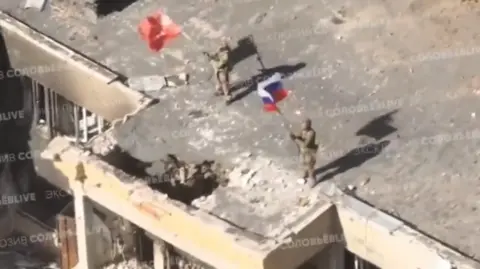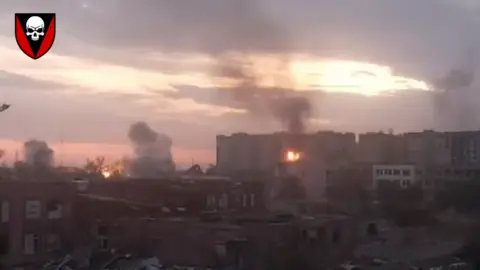Russians claim key city of Vuhledar in Ukraine’s east
Russian troops have taken complete control of the eastern city of Vuhledar, which Ukrainian forces have been defending since the beginning of Moscow’s full-scale invasion two and a half years ago.
Ukraine’s eastern military command confirmed on Wednesday that they had told the troops still fighting in parts of the Vuhledar to pull back to avoid becoming surrounded.
For more than two years Russia has been trying to take this city in order to advance further north and reach regional transportation hubs such as Kurakhove and Pokrovsk.
Pro-Kremlin military bloggers had posted several videos the day before showing Russian soldiers with flags on rooftops of different buildings in Vuhledar.
Donetsk regional authorities confirmed on Tuesday that Russian troops had almost reached the city centre, and some reports said Ukrainian forces are still hanging on in some districts.
 Russian social media
Russian social mediaThe BBC has spoken to two soldiers from the 72nd brigade who managed to leave the city before the final assault and take up new positions in the same area. They claim that their troops have withdrawn from the city.
Over the past few days Ukrainian soldiers had to find their own way out of Vuhledar by foot as it was impossible to evacuate them otherwise, a machine-gunner who wished to remain anonymous said.
Many were wounded and killed by Russian drones and artillery as they tried to leave, another soldier, Roman, says. Many more are still missing.

Moscow has launched numerous attacks to seize the city since the start of the full-scale invasion in February 2022, but they all failed up until now. One of the biggest tank battles took place there last year.
Instead of launching frontal assaults, the Russian army recently switched to its favourite tactic – advancing along the flanks to surround the target. Last month they seized the village of Prechystivka to the west and Vodyane to the east to complete a pincer movement.
Moscow’s enormous advantage in weapons and troops – some soldiers have estimated the ratio of forces as seven to one – enabled them to break through Ukrainian defence lines along the flanks and approach Vuhledar.
It became clear that the city was doomed when the Russians effectively cut off the only remaining lifeline route – the road from Vuhledar to Bohoyavlenka. Russian troops advanced so close that their artillery and kamikaze drones targeted anyone and anything moving on that road.
“We tried to send supplies, organise evacuation of our wounded and dead soldiers but without any success,” Roman said. “We lost a number of vehicles and then had to stop [such operations].”
By Tuesday, about 100 civilians remained in Vuhledar, out of a pre-war population of 14,000, according to Donetsk regional head Vadym Filashkin.
“Thank God, we evacuated all children. Regarding the 107 people who are still there, it’s difficult to reach them and bring them humanitarian aid, drinking water, medicine because an active stage of war is under way.”
 Ukraine 72nd Brigade/Facebook
Ukraine 72nd Brigade/FacebookThe situation became critical when Russian troops entered the city, and Ukrainian units started retreating without waiting for the order to pull out.
“If a withdrawal is not organised, it ends up being chaotic,” the machine-gunner explained. Ukrainian defenders were like Titans trying to stop the Russians, he said. But some groups, he added, had become completely disoriented because of a communication blackout. Their radios were down, and when they came under heavy fire, they had to make quick decisions on their own and often it was to retreat.
Ukrainian defence lines were devastated by Russia’s aviation bombs and thermobaric weapon systems such as its Solntsepek heavy flame-thrower, in addition to drones and multiple rocket launchers.
Facing such an onslaught, withdrawing from certain positions became unavoidable, Roman argued. “You either die or retreat.”
But getting out from a city that had been nearly surrounded was extremely dangerous. During the daytime it became close to a suicide mission.
Ukraine’s troops mostly tried to escape at night, having to cross mine fields via designated paths to avoid the road because it was closely monitored by the Russians.
Until recently, evacuation vehicles had been able to drive in under cover of darkness with their headlights off, Roman explained. But once Russian troops had reached the centre of the city, the only way to escape was on foot.
Those who managed to get out are exhausted and depressed. They are also angry at their commanders for not ordering the retreat earlier, because they argue it was obvious for some time that Ukrainian forces wouldn’t be able to hold the city for long.
“I don’t know why [they didn’t give the order],” the machine-gunner said. “Maybe it’s fear of the military leadership or maybe it was an order from the top [to hold positions] with our blood until the very end.”
Military officials from the 72nd brigade and Ukraine’s operational command in the area refused the BBC’s request to comment.
In their most recent daily briefings, the military’s General Staff kept silent about Vuhledar.
Wednesday morning’s briefing said merely that the “the enemy launched unsuccessful attacks on our positions in Bohoyavlenka’s direction”, without mentioning the situation in Vuhledar at all.



